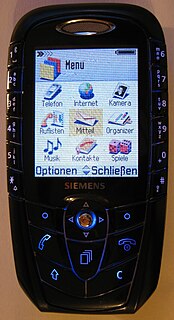Bluetooth is a short-range wireless technology standard that is used for exchanging data between fixed and mobile devices over short distances using UHF radio waves in the ISM bands, from 2.402 GHz to 2.48 GHz, and building personal area networks (PANs). It was originally conceived as a wireless alternative to RS-232 data cables. It is mainly used as an alternative to wire connections, to exchange files between nearby portable devices and connect cell phones and music players with wireless headphones. In the most widely used mode, transmission power is limited to 2.5 milliwatts, giving it a very short range of up to 10 meters (30 feet).

A computer worm is a standalone malware computer program that replicates itself in order to spread to other computers. It often uses a computer network to spread itself, relying on security failures on the target computer to access it. It will use this machine as a host to scan and infect other computers. When these new worm-invaded computers are controlled, the worm will continue to scan and infect other computers using these computers as hosts, and this behavior will continue. Computer worms use recursive methods to copy themselves without host programs and distribute themselves based on the law of exponential growth, thus controlling and infecting more and more computers in a short time. Worms almost always cause at least some harm to the network, even if only by consuming bandwidth, whereas viruses almost always corrupt or modify files on a targeted computer.

Malware is any software intentionally designed to cause disruption to a computer, server, client, or computer network, leak private information, gain unauthorized access to information or systems, deprive users access to information or which unknowingly interferes with the user's computer security and privacy. By contrast, software that causes harm due to some deficiency is typically described as a software bug. Malware poses serious problems to individuals and businesses. According to Symantec’s 2018 Internet Security Threat Report (ISTR), malware variants number has got up to 669,947,865 in 2017, which is twice as many malware variants in 2016.
In computing terminology, a macro virus is a virus that is written in a macro language: a programming language which is embedded inside a software application. Some applications, such as Microsoft Office, Excel, PowerPoint allow macro programs to be embedded in documents such that the macros are run automatically when the document is opened, and this provides a distinct mechanism by which malicious computer instructions can spread. This is one reason it can be dangerous to open unexpected attachments in e-mails. Many antivirus programs can detect macro viruses; however, the macro virus' behavior can still be difficult to detect.

A smartphone is a portable device that combines mobile telephone and computing functions into one unit. They are distinguished from feature phones by their stronger hardware capabilities and extensive mobile operating systems, which facilitate wider software, internet, and multimedia functionality, alongside core phone functions such as voice calls and text messaging. Smartphones typically contain a number of metal–oxide–semiconductor (MOS) integrated circuit (IC) chips, include various sensors that can be leveraged by pre-included and third-party software, and support wireless communications protocols.

This timeline of computer viruses and worms presents a chronological timeline of noteworthy computer viruses, computer worms, Trojan horses, similar malware, related research and events.

In computing, a zombie is a computer connected to the Internet that has been compromised by a hacker via a computer virus, computer worm, or trojan horse program and can be used to perform malicious tasks under the remote direction of the hacker. Zombie computers often coordinate together in a botnet controlled by the hacker, and are used for activities such as spreading e-mail spam and launching distributed denial-of-service attacks against web servers. Most victims are unaware that their computers have become zombies. The concept is similar to the zombie of Haitian Voodoo folklore, which refers to a corpse resurrected by a sorcerer via magic and is enslaved to the sorcerer's commands, having no free will of its own. A coordinated DDoS attack by multiple botnet machines also resembles a "zombie horde attack", as depicted in fictional zombie films.

The Siemens SX1 is a GSM mobile phone running version 1.2 of the Series 60 platform for the Symbian OS. It was the first such smartphone from Siemens following its licensing agreement with Nokia for the use and development of Series 60. Though unveiled in February 2003, it was not launched until December of that year.
ILOVEYOU, sometimes referred to as Love Bug or Love Letter for you, is a computer worm that infected over ten million Windows personal computers on and after 5 May 2000 when it started spreading as an email message with the subject line "ILOVEYOU" and the attachment "LOVE-LETTER-FOR-YOU.TXT.vbs." The latter file extension, was most often hidden by default on Windows computers of the time, leading unwitting users to think it was a normal text file. Opening the attachment activates the Visual Basic script. The worm inflicts damage on the local machine, overwriting random types of files and sends a copy of itself to all addresses in the Windows Address Book used by Microsoft Outlook. This made it spread much faster than any other previous email worm.

The features of mobile phones are the set of capabilities, services and applications that they offer to their users. Mobile phones are often referred to as feature phones, and offer basic telephony. Handsets with more advanced computing ability through the use of native code try to differentiate their own products by implementing additional functions to make them more attractive to consumers. This has led to great innovation in mobile phone development over the past 20 years.
Mobile malware is malicious software that targets Kg or wireless-enabled Lff (PDA), by causing the collapse of the system and loss or leakage of confidential information. As wireless phones and PDA networks have become more and more common and have grown in complexity, it has become increasingly difficult to ensure their safety and security against electronic attacks in the form of viruses or other malware.
This a non-exhaustive list of notable antivirus and Internet Security software, in the form of comparison tables, according to their platform and their operating systems.
Man-in-the-browser, a form of Internet threat related to man-in-the-middle (MITM), is a proxy Trojan horse that infects a web browser by taking advantage of vulnerabilities in browser security to modify web pages, modify transaction content or insert additional transactions, all in a covert fashion invisible to both the user and host web application. A MitB attack will be successful irrespective of whether security mechanisms such as SSL/PKI and/or two- or three-factor authentication solutions are in place. A MitB attack may be countered by using out-of-band transaction verification, although SMS verification can be defeated by man-in-the-mobile (MitMo) malware infection on the mobile phone. Trojans may be detected and removed by antivirus software; this approach scored a 23% success rate against Zeus in 2009 and still low rates in a 2011 report. The 2011 report concluded that additional measures on top of antivirus software were needed.

A computer virus is a type of computer program that, when executed, replicates itself by modifying other computer programs and inserting its own code. If this replication succeeds, the affected areas are then said to be "infected" with a computer virus, a metaphor derived from biological viruses.

Symbian is a discontinued mobile operating system (OS) and computing platform designed for smartphones. Symbian was originally developed as a proprietary software OS for PDAs in 1998 by the Symbian Ltd. consortium. Symbian OS is a descendant of Psion's EPOC, and was released exclusively on ARM processors, although an unreleased x86 port existed. Symbian was used by many major mobile phone brands, like Samsung, Motorola, Sony Ericsson, and above all by Nokia. It was also prevalent in Japan by brands including Fujitsu, Sharp and Mitsubishi. As a pioneer that established the smartphone industry, it was the most popular smartphone OS on a worldwide average until the end of 2010, at a time when smartphones were in limited use, when it was overtaken by iOS and Android. It was notably less popular in North America.

Mobile security, or more specifically mobile device security, is the protection of smartphones, tablets, and laptops from threats associated with wireless computing. It has become increasingly important in mobile computing. Of particular concern is the security of personal and business information now stored on smartphones.
Commwarrior is a Symbian Bluetooth worm that was the first to spread via Multimedia Messaging Service (MMS) and Bluetooth. The worm affects only the Nokia Series 60 software platform.
Shedun is a family of malware software targeting the Android operating system first identified in late 2015 by mobile security company Lookout, affecting roughly 20,000 popular Android applications. Lookout claimed the HummingBad malware was also a part of the Shedun family, however, these claims were refuted.
Ikee was a worm that spread by Secure Shell connections between jailbroken iPhones. It was discovered in 2009 and changed wallpapers to a photo of Rick Astley.The code from Ikee was later used to make a more malicious iPhone malware, called Duh.
HummingBad is Android malware, discovered by Check Point in February 2016.







